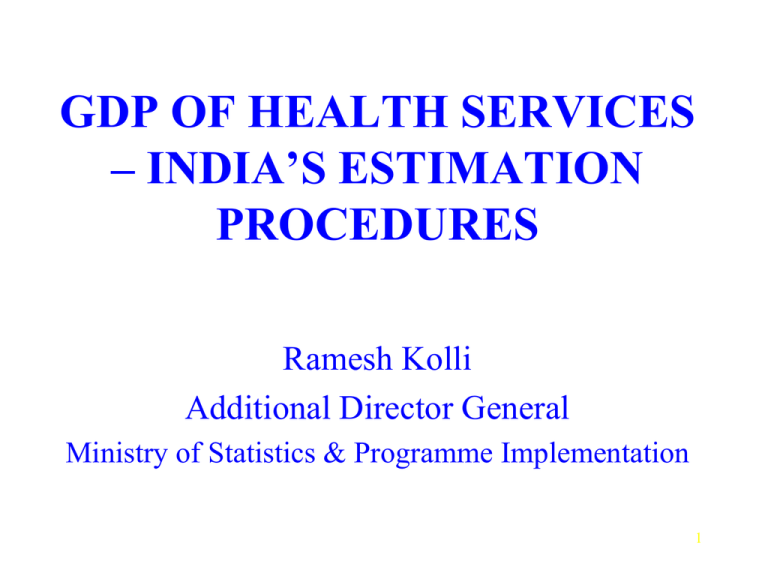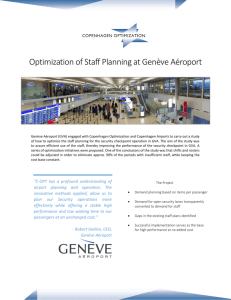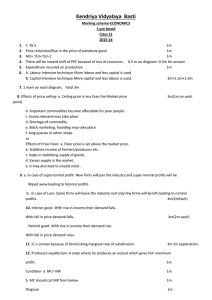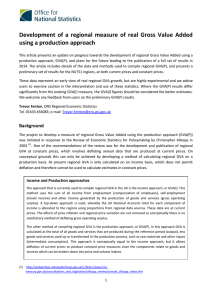GDP OF HEALTH SERVICES – INDIA’S ESTIMATION PROCEDURES Ramesh Kolli
advertisement

GDP OF HEALTH SERVICES – INDIA’S ESTIMATION PROCEDURES Ramesh Kolli Additional Director General Ministry of Statistics & Programme Implementation 1 Outline of presentation • • • • • • Issues Coverage of Health Services Sources of Data Method of Estimating GVA at nominal prices Method of Estimating GVA at constant prices Concluding remarks 2 Issues • • Measuring output and value added of services is difficult, compared to goods producing industries – Especially if these are for non-market producers and at constant prices Generally, output in nominal terms is measured – For market producers from the books of accounts broadly as sum of sales and changes in inventories – For non-market producers, on input cost approach, as sum of inputs, compensation of employees and consumption of fixed capital • • • For both market and non-market producers, output and value added in real terms is estimated applying price deflators (CPI/PPI) or by extrapolating base year estimates with volume indicators This procedure gives rise to incorrect measures of volumes of output, especially for non-market producers Vast literature on better measurement is available in public domain – OECD Handbook ‘Measuring Education and Health Volume Output’ – The 1993 SNA – UK-ONS’s Atkinson Review on Measurement of Government Output and Productivity for the National Accounts – Eurostat Handbook on price and volume measures in national accounts 3 Coverage of Health Services • 3-digit codes of ISIC Rev 3.0 : • 851 – Human Health Activities – 8511 - Hospital activities – 8512 - Medical and dental practice activities – 8519 - Other human health activities • 852 – Veterinary activities [including clinicopathological and other diagnostic activities pertaining to animals and birds] • 853 - Social work activities – not included, though it is part of Tabulation Category N and Division 85 4 Sources of Data • • • Public Sector (general government) – Budget documents of all levels of government Private Corporate Sector (non-government financial and non-financial corporations) – Annual accounts Private Unorganised Sector (Household sector and NPISHs) – Benchmark estimates through Labour input method • Employment (jobs) in unorganised sector – 5-yearly surveys • Value added per worker – 5-yearly enterprise surveys – Annual estimates • Administrative data on number of medical and para-medical personnel • household consumption expenditure of health services – annual growth rate estimated from the 5-yearly Consumer Expenditure Surveys of NSSO 5 Method of Estimating GVA at nominal prices – public sector • input cost approach (total costs incurred in their production) • sum of intermediate consumption, compensation of employees, consumption of fixed capital (CFC) (for output at factor cost) and other taxes, less subsidies, on production (for output at basic prices). • Data on intermediate consumption and compensation of employees is compiled by analysing the budget documents (i.e., after reclassifying the item-wise expenditures of government according to economiccum-purpose classification) of all levels of government • For CFC, since no allowance is made in budgets, it is estimated separately through the perpetual inventory method (PIM) • For GVA, intermediate consumption is excluded from the output • No operating surplus for public authorities • Measured on cost basis – not accrual 6 Private corporate sector • • Annual accounts analysed by RBI GVA at factor cost is measured as gross output less intermediate consumption or as sum of compensation of employees and gross operating surplus. The production taxes net of production subsidies is added to the GVA at factor cost to obtain GVA at basic prices The RBI analysis is based on sample accounts, and sometimes reliable estimates are not available for health services Alternative is the labour input method • • – – Administrative sources for annual employment data Value added per worker from enterprise surveys-corporate sector part – Annual estimates - using annual growth rate estimated from the 5- yearly Consumer Expenditure Surveys of NSSO 7 Private unorganised sector – labour input method – GVA estimated initially for a benchmark year using the labour input method – Other years - benchmark GVA is extrapolated with suitable indicators – growth in consumption expenditure GVA of health services in private unorganised sector in the benchmark year = Workforce in establishments producing health services in private unorganised sector (total workforce in this activity– workforce in public and private corporate sectors in the same activity) * Gross Value Added Per Worker 8 Contd… • GVA data released both at factor cost and at basic prices • For the basic price estimates, information available from the budget documents is on total production taxes and total production subsidies • these are allocated to different sectors and industries on the basis of year-wise estimates of net capital stock • Out of the total GVA of health services, public, private corporate and private unorganised sectors account for 30%, 10% and 60%, respectively 9 Method of Estimating GVA at constant prices • Public Sector – deflate the corresponding estimates of output and GVA at nominal prices by the CPI for industrial workers, which is used as a wage index for government employees • Private Corporate Sector – Volume indicators of number of medical and para-medical personnel – Due to time-lag and also this procedure does not take into account improvements in productivity, this volume indicator has been discontinued – Presently current price estimates are deflated by the CPI. • Private Unorganised Sector – current price estimates are deflated by the CPI 10 CONCLUDING REMARKS • Measuring health services output at nominal prices or in real terms, by both market and non-market producers is extremely challenging. • same services are measured differently for market and non-market producers • The real output should be measured in terms of volumes which takes into account the outputs, outcomes and quality of services, both for market and non-market producers • However, in practice it is difficult to obtain reliable data on these, and there is also the problem of aggregating volumes of different health services into a single output indicator • Important points – Capital stock and CFC estimated through PIM – Public sector – all levels of government and autonomous government institutions are covered – Labour input method for exhaustiveness – CPI which is a kind of wage index, used as deflator for real GVA 11 Thanks 12







